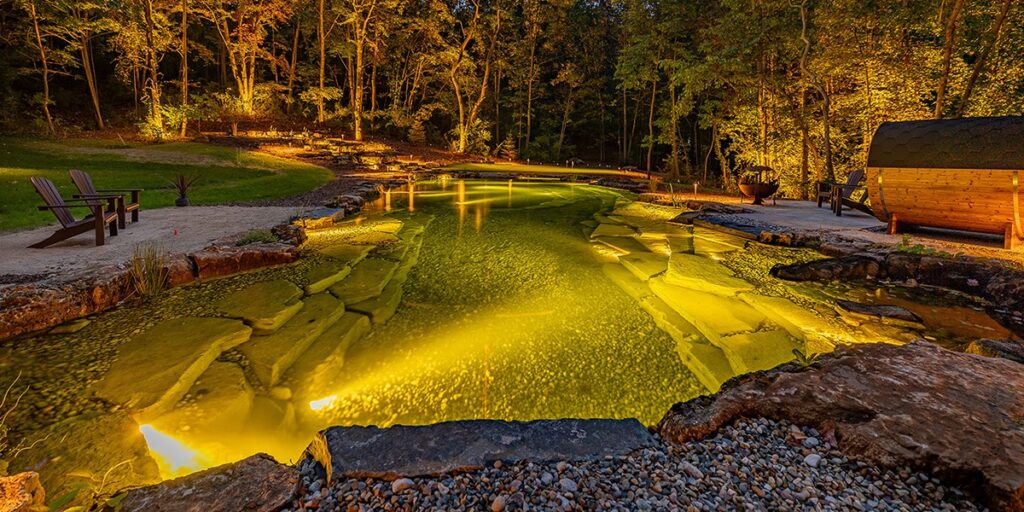
Like so many types of koi, Utsurimono is a variety defined by its color. Utsurimono are black-based koi, and the family contains three versions, each with its own additional color: Shiro Utsuri with white, Hi Utsuri with red and Ki Utsuri with yellow.
Like Showa, the dynamic sumi (black) pattern of Utsurimono is very attractive in all of its versions. (Showa also belongs to Utsurimono. Because the Showa variety is too big to simply be categorized as one of the Utsurimono variety, however, Showa is usually treated as its own independent variety.)
Out of the three varieties of Utsurimono, Ki Utsuri is the oldest. There is a record that says Ki Utsuri was born and sold for very high prices in 1899, but it was about 1920 when this variety was fixed. In 1924, Hi Utsuri and Shiro Utsuri were developed.
Why are they called “Utsurimono”? The term “utsuri” in “Utsuri mono” means “seethrough” or “reflection.” In the old days, when Ki Utsuri first came out, the ki (or yellow) looked like it was coming through the sumi, the ground color. This is why it was called Ki Utsuri. The “mono” of “Utsurimono” means “things.” So Utsurimono means a group of things (in this case, koi) that has utsuri characteristics.
Although Ki Utsuri was the very first variety of Utsurimono, it once almost disappeared from the industry because Hi Utsuri and Shiro Utsuri became so popular. When I had just started working for my father in Japan more than 15 years ago, I remember there being many inquiries about this variety from many of my foreign clients. Although I ran all over Niigata, it was almost impossible
to find one.
I think it was about this same time that Mr. Isa from Maruyo Koi Farm realized we were in danger of losing this historically important variety in the koi industry and started breeding it. I personally think the variety of Ki Utsuri was saved thanks to two things: the high demand from overseas, and Mr. Isa. Nowadays, Ki Utsuri has a constant demand and I have a few good places to go to buy quality ones.



### Utsurimono Appreciation ###
Because Utsurimono are very simple two-colored koi, there are not many things on the checklist to watch for. But because of the simplicity, the degree of the quality determines the value of the koi. It is also important to understand that although the basic approach is the same, the level of development in each variety varies. We can not simply compare each variety directly.

### Sumi Quality ###
As the base of Utsurimono, the sumi (black) quality is very important. The depth and lacquer-like quality of the sumi is key. Because Shiro Utsuri is definitely the most popular variety of them all and has been advanced the most, the sumi quality of that version is much better than that of the other two.
Ki Utsuri and Hi Utsuri cannot help having jami, or speckles on the body. Jami would be a huge disadvantage in Shiro Utsuri, but in these two varieties, some jami are still forgiven. But of course, because jami does disgrace the beauty of koi, the less jami there are, the cleaner and more beautiful the koi looks. Less jami is preferred for Ki Utsuri and Hi Utsuri. This is why Shiro Utsuri usually wins in the category of Utsurimono at koi shows.
### Ki, Hi and Shiroji Quality ###
The quality of the other color is also important. Shiro (or white) must be snow white. Ki needs to as yellow as possible. Hi, of course, must be as red as possible. Needless to say, the skin color must be consistent all the way.
### Pattern ###
After all, the beauty of koi is the balance of two colors. When the colors are evenly distributed throughout the body, koi look beautiful. There are a few things you should know when checking the pattern of Utsurimono.
### Menware (or Hachiware) pattern ###
This is a type of sumi pattern that divides the face. This is an ideal face pattern of this kind.
### Ichimatsu pattern ###
Ichimatsu is basically a checkerboard pattern. For the two colors to be attractive, this would be the ideal design of this kind.
### Odome ###
Just like other varieties, odome (or tail stop) is always important. If sumi goes all the way to the tail, no matter how good the rest of the body is, the beauty will not be complete. It is ideal to have some white, yellow or red there in the tail.

### Motoguro ###
In Utsurimono, motoguro pattern (sumi on the base of the pectoral fins) is not always a must. You will sometimes see beautiful motoguro in Shiro Utsuri, and if you do, that adds the value to the koi. But in Ki Utsuri or Hi Utsuri, you hardly see motoguro. And I think it is still too demanding to ask for the refined motoguro on Hi Utsuri and Ki Utsuri.
When it comes to Utsurimono, there are definitely a few breeders you should know for their quality koi.
Omosako is a brand of quality Shiro Utsuri. Ushizo (Shinoda Koi Farm) is known for Hi Utsuri. Their Hi Utsuri grow huge, which is one of the advantages of that variety.
As for Ki Utsuri, Maruyo Koi Farm (who saved the variety) and Otsuka Koi Farm are the places to go. I doubt it would be very difficult to find Ki Utsuri other than these two places.
### Selling Utsurimono ###
Selling Utsurimono is always fun, and these varieties should be part of your regular stock. Shiro Utsuri is the most popular. When selling small ones, some Shiro Utsuri have some sumi already developed while others do not. Either way, you have to explain to your customers what these koi will look like as they grow.
As for Hi Utsuri, you can stress the beauty of the black/red contrast and the growth potential. It’s always good to mention the rarity of Ki Utsuri to your clients and discuss the story of how they almost disappeared. In addition, I think it is important and helpful to have older, bigger and more developed koi in stock. This way, your clients can visualize what the smaller koi may turn into. That always makes the sale easier.


